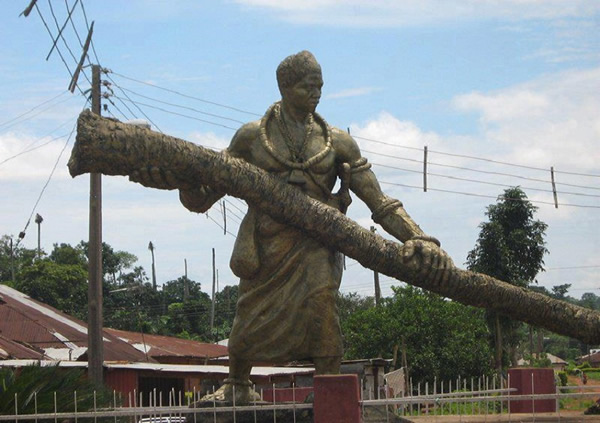
Idubor, the giant warrior prince of Benin who could uproot palm trees with his bare hands
Idubor came into this world at a time Great Benin was an important state that flourished in southern Nigeria. Also known as Arhuanran (sometimes spelled Aruanran), Idubor would have been the Oba (king) of Benin in the 1500s had his birthright not been taken away from him and given to his younger brother, Esigie, who was born on the same day he was.
According to history, Idubor’s mother gave birth to him a few hours before Esigie was born. However, because Idubor did not immediately cry at birth, Esigie, who did, was reported first to the king, Oba Ozolua, and his proclamation rights were performed. Idubor and Esigie had an older brother, Ogidigbo, who was the first son and thus next in line to the throne. But Ogidigbo broke his leg in a competition with his two brothers, and becoming cripple meant he had lost his right from taking over from his father.
As tradition demanded, Esigie, who was now the second child (after taking his brother, Idubor’s birthright) moved up to the first place, becoming the next in line to succeed his father to the throne. Locals accused Esigie’s mother, Idia, of being behind his brother Ogidigbo’s woes, claiming that she used mystical powers to improve her son’s chances of becoming the next Oba; this was not uncommon for royal wives to do at the time.
These and many other factors angered Idubor, and he would go to war with his brother on several occasions.
Their father, before his death, carved out dukedoms for both of them to avoid confusion — Idubor was made the Duke of Udo, a town not too far from Benin. But Idubor was not satisfied and continued to battle his brother, even making plans to assassinate him.
Idubor had then become a great warrior and conqueror and had grown up to be a giant. “Legend has it that he uprooted palm trees with his bare hands, sweeping the ground with the fronds. He turned out to be a great warrior who had the overwhelming advantage of size and stamina,” an account by Edo Historical Traditional Cultural Heritage says.
Another historical account states that Idubor “was bigger and stronger, and could easily have trounced the weaker Esigie, whom Oba Ozolua had sent to attend the Portuguese mission school after his baptism.”
Idubor could have therefore succeeded with his plans to kill his brother, Esigie had the latter’s mother, who was his spiritual protector, not intervened. Idia took on Idubor using mystical powers and his plans failed.
When Esigie later ascended the throne after the death of their father, many thought the power struggle between the two brothers would end. However, Idubor refused to concede defeat, and instead, he went back to Udo. There, with his army and his “newly acquired magical prowess” against Esigie, he began attacking the capital. An oral account states that Idubor even placed spells on the coronation beads of Esigie, driving him mad for days until he was cured.
The bitter war between Idubor and Esigie meanwhile continued in what became one of the bloodiest wars in Benin history. Idubor and his town Udo were eventually defeated in the battle and Idubor drowned himself in a lake – Lake Odighi N’Udo.
History says Esigie’s victory was during the planting season when many members of Idubor’s army, who were farmers, had gone to their farms.
Esigie would go on to reign over the ancient Benin Kingdom while maintaining a strong connection to Portugal throughout his reign. Becoming the first leader in the West-African Sub-Region to establish diplomatic relations with a European country, Esigie encouraged extensive trade with the Europeans though ensuring that his kingdom was independent of their control.
But the powerful Esigie has his mother to thank for his successful reign over Benin. His mother, Idia, became a strong influence on him as he “undertook nothing of importance without having sought her counsel.”
Esigie introduced a special post in the administration for his mother called the Iyoba, the Queen Mother, and commissioned a “highly improved metal art” that has since received wide acclaim. The famous Queen Mother Idia busts are some of the most well-known art pieces.
Idia’s image is also expressively captured in the famous Ivory mask, which served as the logo of the 2nd World Black and African Festival of Arts and Culture (FESTAC), held in 1977 in Lagos, Nigeria.
“The exquisite craftsmanship of the mask bears testimony to the quality of life and superlative level of civilization of the Benin people prior to their colonization,” an article by Trip Down Memory Lane said.
Years later, the British would invade the Benin kingdom and take away various works of art commissioned by Esigie, including Ivory and bronze works before burning down the ancient capital, Benin City. Today, most of these works of art are held in prominent museums, including the Metropolitan Museum of Art and the British Museum.
The Oba of the Benin Kingdom has, nevertheless, stood the test of time even though Nigeria’s history is made up of several unique elements.
While Nigeria is a constitutional democracy that elects its leaders, the hundreds of ethnic communities scattered across the country still acknowledge their own traditional rulers and among the most recognized traditional leaders in Nigeria is the Oba of Benin.


